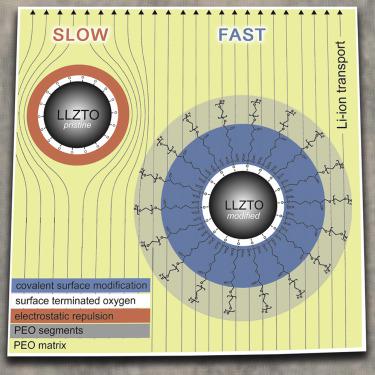Cell Reports Physical Science ( IF 7.9 ) Pub Date : 2020-09-30 , DOI: 10.1016/j.xcrp.2020.100214 Eveline Kuhnert , Lukas Ladenstein , Anna Jodlbauer , Christian Slugovc , Gregor Trimmel , H. Martin R. Wilkening , Daniel Rettenwander

|
Ceramic-polymer electrolytes are expected to improve safety, energy density, and power of next-generation battery technologies. The realization of this type of battery is, however, hindered by the high interfacial resistance across the ceramic-polymer interface. Here, we report a surface-modification strategy to lower the interfacial resistance by more than four orders of magnitude. For this purpose, we activate the surface-terminated oxygen of Li6.4La3Zr1.4Ta0.6O12 (LLZTO) particles by plasma etching and functionalize them by immersing the LLZTO particles in a (3-glycidyloxypropyl)trimethoxysilane (Si-R) solution to form covalently bonded Si-R layers. The Si-Rs are terminated by an epoxy group that reacts with the hydroxyl group of the poly(ethylene oxide) (PEO) via a ring-opening reaction. The modifications improve the screening of the oxygen polarity of LLZTO particles and lower the free volume between both components, resulting in a LLZTO|PEO interface resistance of 500 Ω cm2 at 20°C, the lowest value reported so far to the best of our knowledge.
中文翻译:

降低Li 6.4 La 3 Zr 1.4 Ta 0.6 O 12 |聚(环氧乙烷)复合电解质中的界面电阻
陶瓷聚合物电解质有望改善下一代电池技术的安全性,能量密度和功率。然而,这种类型的电池的实现由于在陶瓷-聚合物界面上的高界面电阻而受到阻碍。在这里,我们报告了一种表面改性策略,可将界面阻力降低四个数量级以上。为此,我们激活了Li 6.4 La 3 Zr 1.4 Ta 0.6 O 12的表面末端氧(LLZTO)颗粒通过等离子刻蚀并通过将LLZTO颗粒浸入(3-环氧丙氧基丙基)三甲氧基硅烷(Si-R)溶液中以形成共价键合的Si-R层来对其进行功能化。Si-R通过环氧基终止,该环氧基通过开环反应与聚环氧乙烷(PEO)的羟基反应。这些修饰改善了LLZTO颗粒氧极性的筛选,降低了两种组分之间的自由体积,导致LLZTO | PEO在20°C时的界面电阻为500Ωcm 2,是迄今为止报道的最低值,这是我们最好的结果。知识。











































 京公网安备 11010802027423号
京公网安备 11010802027423号